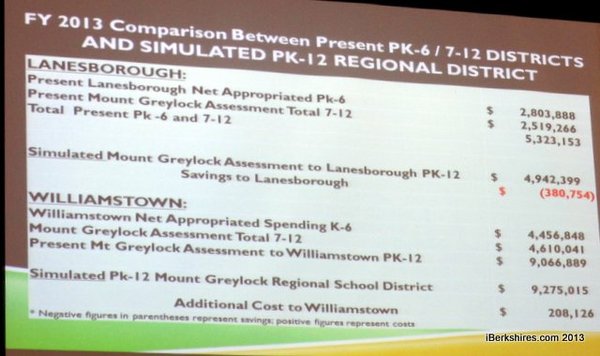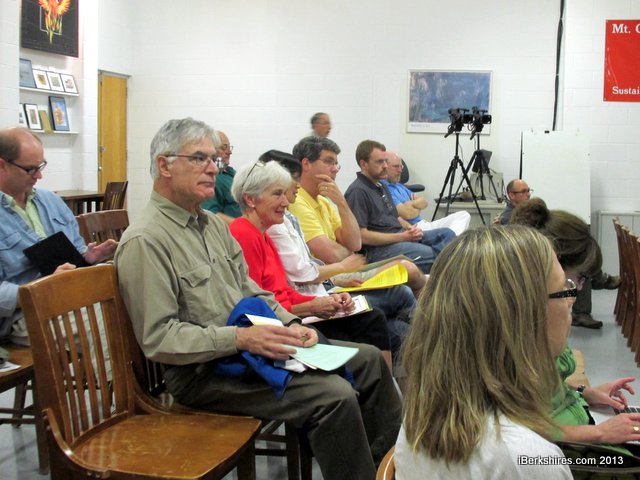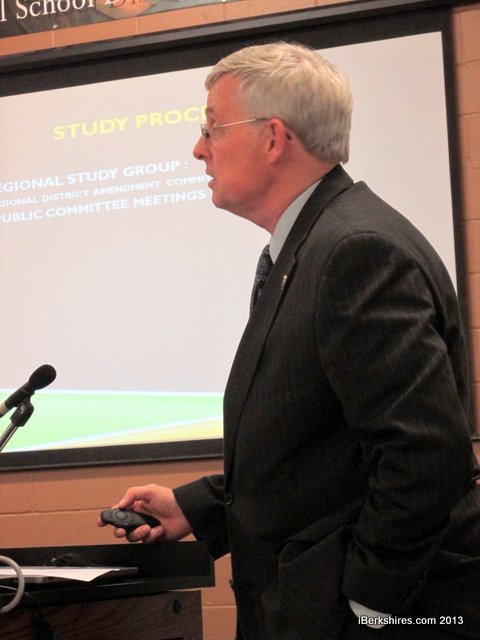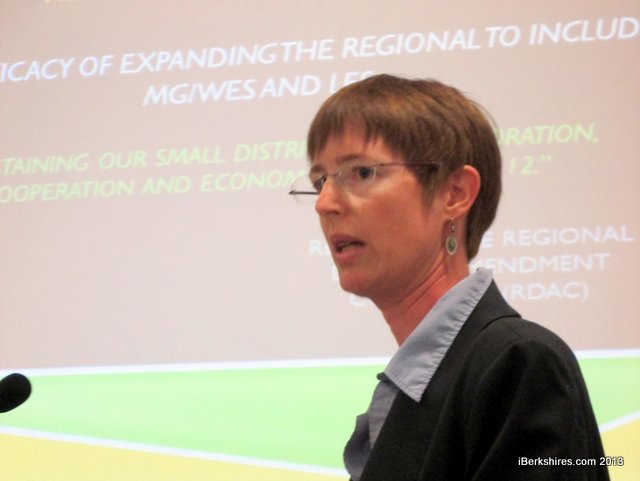Mount Greylock Regionalization Task Force Faces Tough QuestionsBy Stephen Dravis, Williamstown Correspondent
12:23PM / Wednesday, June 19, 2013 | |
 A comparison of estimated costs should the towns join their elementary schools to the Mount Greylock district. A comparison of estimated costs should the towns join their elementary schools to the Mount Greylock district. |
 A number of local officials questioned the regionalization committee on its findings and the costs of regionalizing. A number of local officials questioned the regionalization committee on its findings and the costs of regionalizing. |
WILLIAMSTOWN, Mass. — For five months, the Regional District Amendment Committee has been looking at the pros and cons of expanding the Mount Greylock Regional School District.
On Tuesday, they got a taste of how much more work needs to be done in terms of selling the "pros."
The panel held the first of this week's two public forums in anticipation of a Thursday vote on whether to recommend expansion to the Mount Greylock School Committee.
Although the audience was filled mostly with members of school and town committees, there were several pointed questions from residents about the advantages of turning a Grades 7-through-12 district into a prekindergarten-through-12 district by joining Mount Greylock more formally with its main "feeder" schools, Williamstown Elementary School and Lanesborough Elementary School.
"What are the advantages to Williamstown?" Christopher Nugent of Williamstown asked the RDA Committee. "Why would the town want to give up autonomy and spend a considerably larger amount of money when it's doing fine?"
Local control and — in the case of Williamstown — increased costs figure to be sticking points if and when the School Committee takes regional expansion out of the discussion phase and moves it toward potential town meeting votes in Williamstown and Lanesborough.
According to a simulation run by the amendment committee based on fiscal 2013 numbers, Williamstown's assessment for the PK-6 portion of a hypothetical Mount Greylock district would have been as much as $346,158 higher than its tax bill for an independent Williamstown Elementary School.
By contrast, Lanesborough's bill for elementary school would have gone down by $273,502 in the current fiscal year under a PK-12 district model.
Consultants from the Massachusetts Association of Regional Schools hastened to point out that the $346,158 figure is a worst-case scenario that assumes all employees at the elementary schools would be elevated to the junior-senior high school pay scale in year one of expansion.
"The law does not allow for employees to receive less compensation than they were receiving prior to regionalization," MARS Executive Director Stephen Hemman said. "Generally, it takes several years to negotiate the adjustment."
Hemman explained that regionalization in general saves communities money by creating economies of scale and, most significantly, by consolidating administrations.
The thing about Williamstown and Lanesborough is they are already realizing those cost savings by virtue of creating a "tri-district" model with a single superintendent.
"In Phase 1, you created Union 71 in 2008," Hemman said, referring to the creation of a superintendancy union between Williamstown and Lanesborough. "You combined Union 71 with Mount Greylock in 2010.
"Right now, we're in Phase 2."
Union 71 Superintendent Rose Ellis explained that savings on administration, support staff and purchasing during "Phase 1" added up to about $350,000. And Hemman noted that the bottom line for "Phase 2" would look a lot better if the regional district was being created all at once rather than in phases.
"Usually, Phase 1 and 2 are done at the same time," he said. "You're doing it in distinct blocks."
There are potential cost savings that could accrue from regionalization down the road. The most significant is the fact that the Massachusetts School Building Authority offers financial incentives for districts with expanded regionalization and, as residents in both towns are acutely aware, Mount Greylock is trying very hard to get into the MSBA's funding program to either renovate or rebuild the junior-senior high school.
|
Right, Stephen Hemman of the Massachusetts Association of Regional Schools leads a presentation; below, RDAC and Mount Greylock School Committee Chairwoman Carolyn Greene said regionalization committee may be asked to continue in another form. |
 |
 |
But residents and members of the Williamstown Finance Committee pressed the committee for answers about the disparity between the immediate cost benefits each of the new district's towns would realize.
A handout prepared by the committee addresses that difference.
"Preliminary estimates show that because Lanesborough has higher per-pupil spending levels than Williamstown including costs borne directly by the towns outside their respective school budgets, the likely evening out of expenses under regionalization would be for Lanesborough to spend less and for Williamstown to spend more," the handout reads.
There is more at stake in regionalization than money.
Committee members have emphasized in the past and did again on Tuesday that a fully integrated PK-12 region allows for greater coordination of curriculum. School officials have touted the work of Tri-District Curriculum, Instruction and Assessment Coordinator Mary MacDonald, who served in that capacity for the last year before being named the new Mount Greylock principal last month.
Committee members also have argued that regional expansion would allow that coordination work to continue. But that argument also met resistance in the forum at Mount Greylock.
"On the financial side, I can't see much reason to do this because you've already gotten the gain ... but I'm curious about the curriculum side," said Andrew Hogeland, a member of Williamstown's Finance Committee. "Why can't you do more of the same? Is there an option to do goodwill sharing more aggressively so we know more about what we're doing before we move in together?"
MacDonald said that regionalization will ensure cooperation.
"Goodwill is great, but it's not a guarantee," she said. "That's one thing the principals (of the elementary schools) and I are concerned about. If we're going to establish momentum with the programs at the elementary school that fully support the students moving up to the high school, having a regional focus will help."
The RDA Committee will make its case again Wednesday at 7 p.m. in a public forum at Lanesborough Elementary School. The committee will meet on Thursday at Mount Greylock, when it anticipates voting on whether to recommend regional expansion to the Mount Greylock School Committee.
Once that vote is taken, the ad hoc committee will have discharged its duties and likely will be disbanded. But at Tuesday's meeting of the School Committee (which followed the public forum), Carolyn Greene indicated the panel likely will ask the RDA Committee members to continue serving as a subcommittee of the School Committee.
Margaret McComish, a member of the RDAC and former chairman of the Williamstown School Committee, asked whether the regionalization task force could continue studying the question even after it makes its formal recommendation to the elected body.
"It seemed like the Q&A tonight brought up questions I wasn't comfortable answering," McComish said.
"I'm not opposed to us voting on Thursday and you all constituting a subcommittee. ... As a RDAC committee member, that sounds fine to me."
| 
